Having finished third back in 2015, England will be disappointed with their failure to progress further this time around. Eventual champions the USA sent them packing following a tight semi-final encounter, while Sweden pipped them to bronze in the 3rd place play-off match.
Although the Lionesses’ objective was to leave France with the trophy, there is still plenty of positives to take away from the tournament. This tactical analysis will examine their overall performance at the FIFA Women’s World Cup 2019.
Structure & style of play
Phil Neville varied his formation between 4-1-4-1, 4-2-3-1 and 4-4-2. The structure in place typically reflected the level of opposition, with the former Manchester United defender preferring to play with a double pivot against more challenging opponents.
There was also a significant amount of variation in terms of personnel. Goalkeeper’s Carly Telford and Karen Bardsley were rotated, while left-backs Alex Greenwood and Demi Stokes also shared game time. The two wide slots were contested for by Toni Duggan, Beth Mead, Rachel Daly, and Nikita Parris. Meanwhile, striker Ellen White provided a reliable source of goals throughout the competition.
The image below shows their line-up in the opening fixture against Scotland. Fran Kirby and Jill Scott enjoyed free roles between the lines, occasionally dropping deeper to support build-up. 22-year-old Keira Walsh played as a single pivot in front of central defenders Steph Houghton and Millie Bright. Parris was supported on the right-wing by talented Lyon fullback Lucy Bronze.
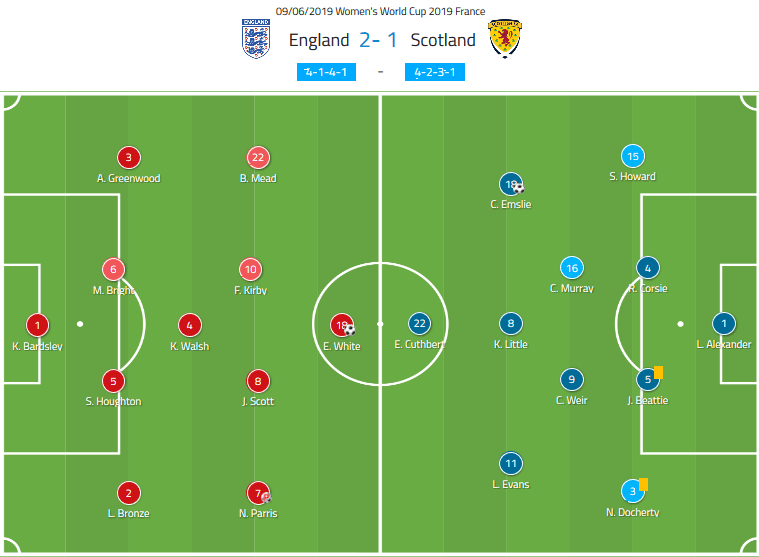
England‘s style of play also varied from game to game, although some aspects of their system remained stable. Regardless of the obstacles in front of them, Neville’s side showed a commitment to building out from the back, looking to progress through the thirds.
Their approach in the final third saw them make intelligent use of possession, shifting the ball from side to side in search of an opening. They also incorporated the third man concept in their game, looking to create overloads out wide and free players in the attack. Scott and Bronze were often the ones tasked with making late runs into the box to cause confusion for the opposing defence, as well as providing the winger with an extra option to aim for.
Bronze made regular movements infield, both to support the pivot player in circulating possession, and to carry the ball through gaps in the opponent’s midfield line. The former Liverpool defender varied her game between playing as an inverted full-back and holding width on the right, where she recorded a cross accuracy of 46.7%. In these instances, Parris could join the central attack to support White.
Overall, their style of play and the structures used can generally be regarded as protagonistic. More often than not, they looked to impose themselves on games, dictating the play rather than simply taking a reactive stance. As we will see in this analysis, however, it wasn’t always straight forward.
Problems during build-up
A pattern that emerged early on, opposing teams often looked to shut off the passing lanes between the centre-backs and the pivot midfielder. Walsh found herself taken out of the game on numerous occasions by the opposition striker’s cover shadows.
This made it difficult for England to break through centrally, forcing them to find progress via the fullbacks. As mentioned, we sometimes saw one of the offensive midfielders drop deeper in these scenarios, but it rarely had the desired effect.
In the image below, the Japanese centre-forwards pair up to prevent passes into Walsh. Kirby withdraws from the attack to support the first phase, offering a passing option to left central defender Bright. However, as she receives the ball with her back to goal, a marker is close by to apply immediate pressure and force a turnover.
A logical solution to this problem might have been to play a first-time lay-off into the feet of Walsh, allowing her to carry the play forward instantly. Instead, Kirby tries to receive and turn to progress the move herself, ultimately handing over possession to Asako Takakura’s side.
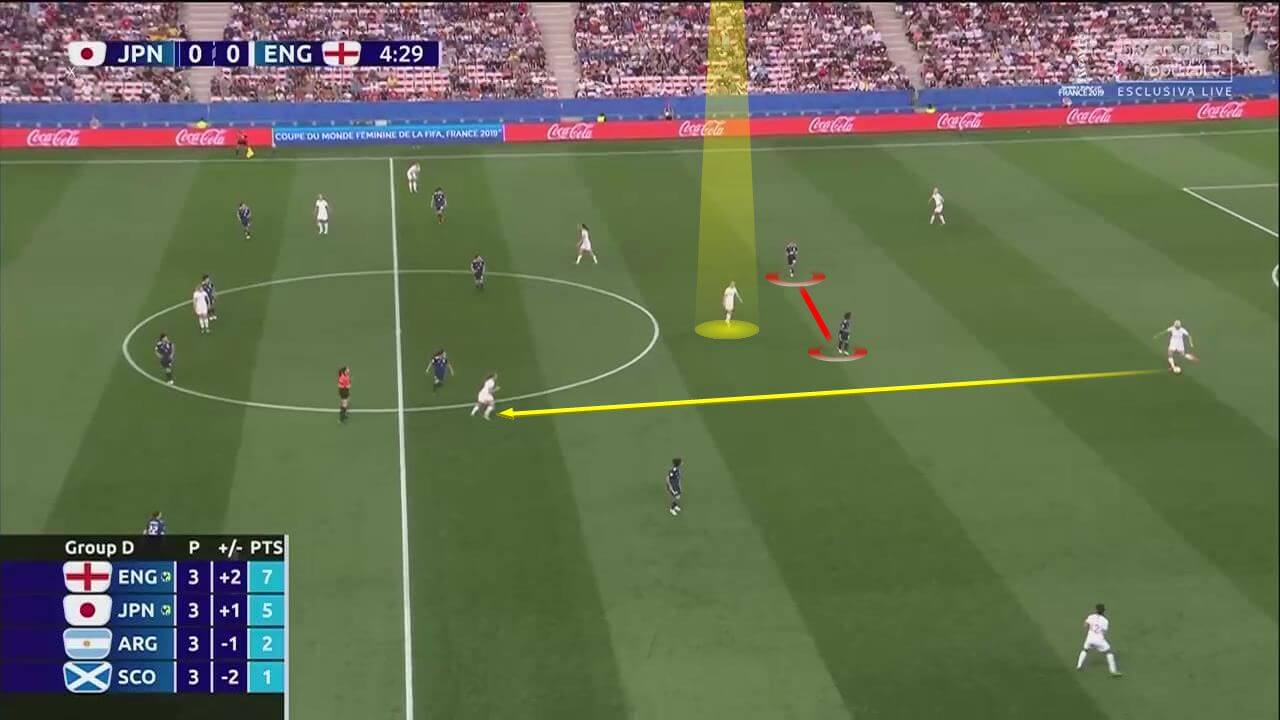
Another issue they faced involved teams defending in an extremely deep unit. Argentina were the most obvious example of this, having possession for just 24% of their battle.
Accepting inferiority on a technical level, the Argentine’s decided to sit off and try to frustrate their more illustrious rivals, waiting for counter-attacking moments to emerge. The image below highlights the extent of conservativism in Carlos Borrello’s strategy.
No pressure is applied to the ball occupant, allowing her to shift the play from one flank to the other with ease. Space between the lines was almost non-existent, forcing England to attack down the sides.
Over the course of the 90 minutes, they managed to register 17 shots on goal. However, many of them were speculative, while goalkeeper Vanina Correa put in an outstanding display to keep the scores down.
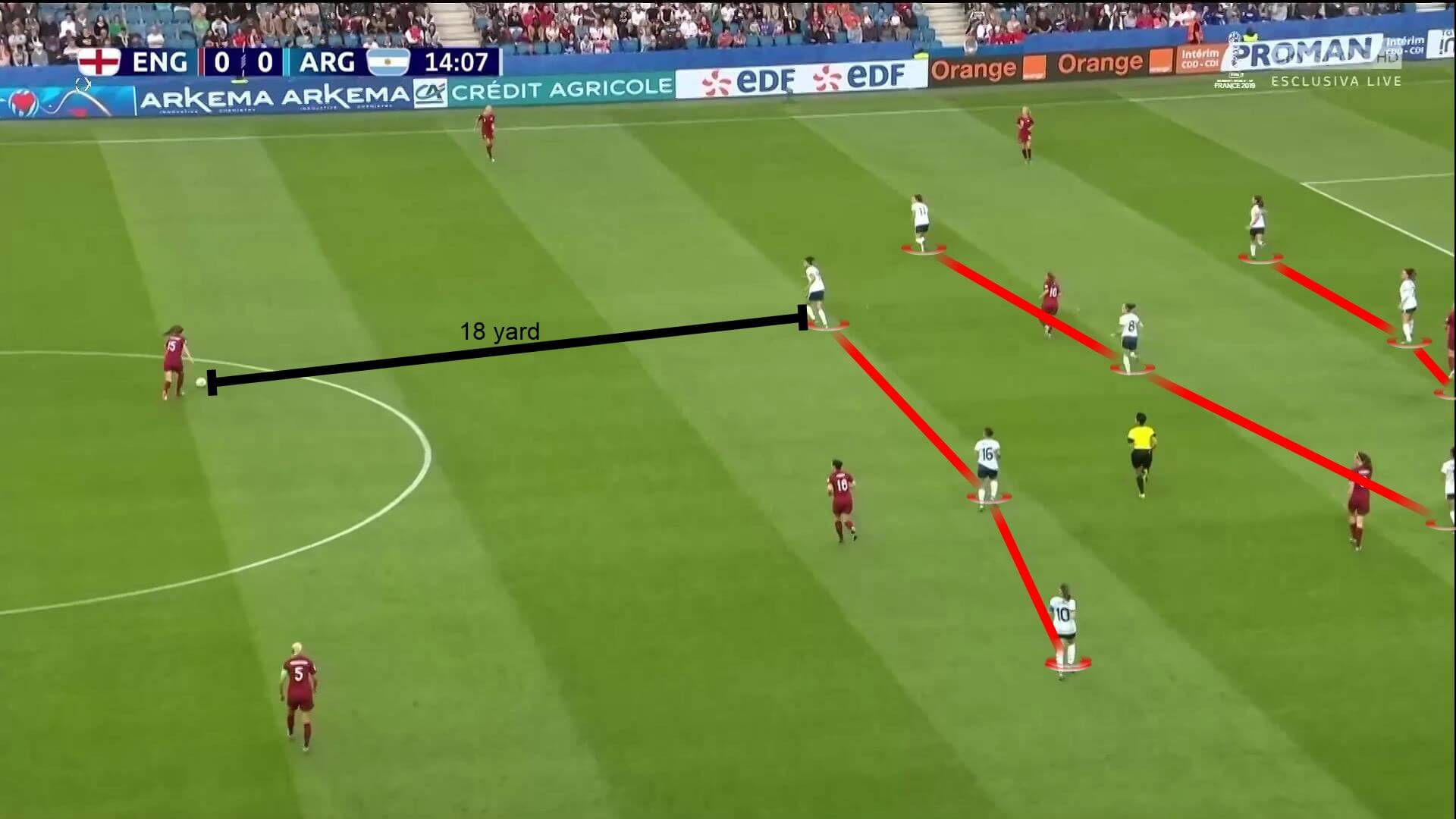
Attacking down the channels wasn’t an issue for Neville’s team, with arguably their two most talented players linking up on the right flank. Bronze and Parris produced some excellent displays, giving us a preview of what to expect at Lyon next season.
As touched upon earlier, Bronze would sometimes move into the centre, allowing Parris the freedom to exploit the wings. On other occasions, Bronze would occupy the wide berth and Parris would play through the middle.
Recognising the threat posed by the dynamic duo, many opponents put a heavy focus on congesting their side of the field. Against the US, much of the pre-match build-up centred on the prospective battle between Bronze and left-winger Megan Rapinoe. As it transpired, Rapinoe spent the entire game on the bench, reportedly nursing a slight hamstring concern.
Her replacement, Christen Press, lived up to her name by applying pressure to England’s right-back at every opportunity. She was further assisted in her defensive duties by multiple teammates, hoping to close out space and stifle their opponent’s most dangerous attacking outlets.
As shown below, Press forces a misplaced pass with effective use of pressure and cover shadows, shutting off the passing lane between Bronze and Parris. In this fixture, the latter started behind White upfront, with Daly positioned on the right. As we can see, Daly would often move infield to drag an opposing defender with her, hoping to create space for the Lyon pair to link up. However, the USA displayed their tactical nous with quick-swap overs to maintain access to each opponent.
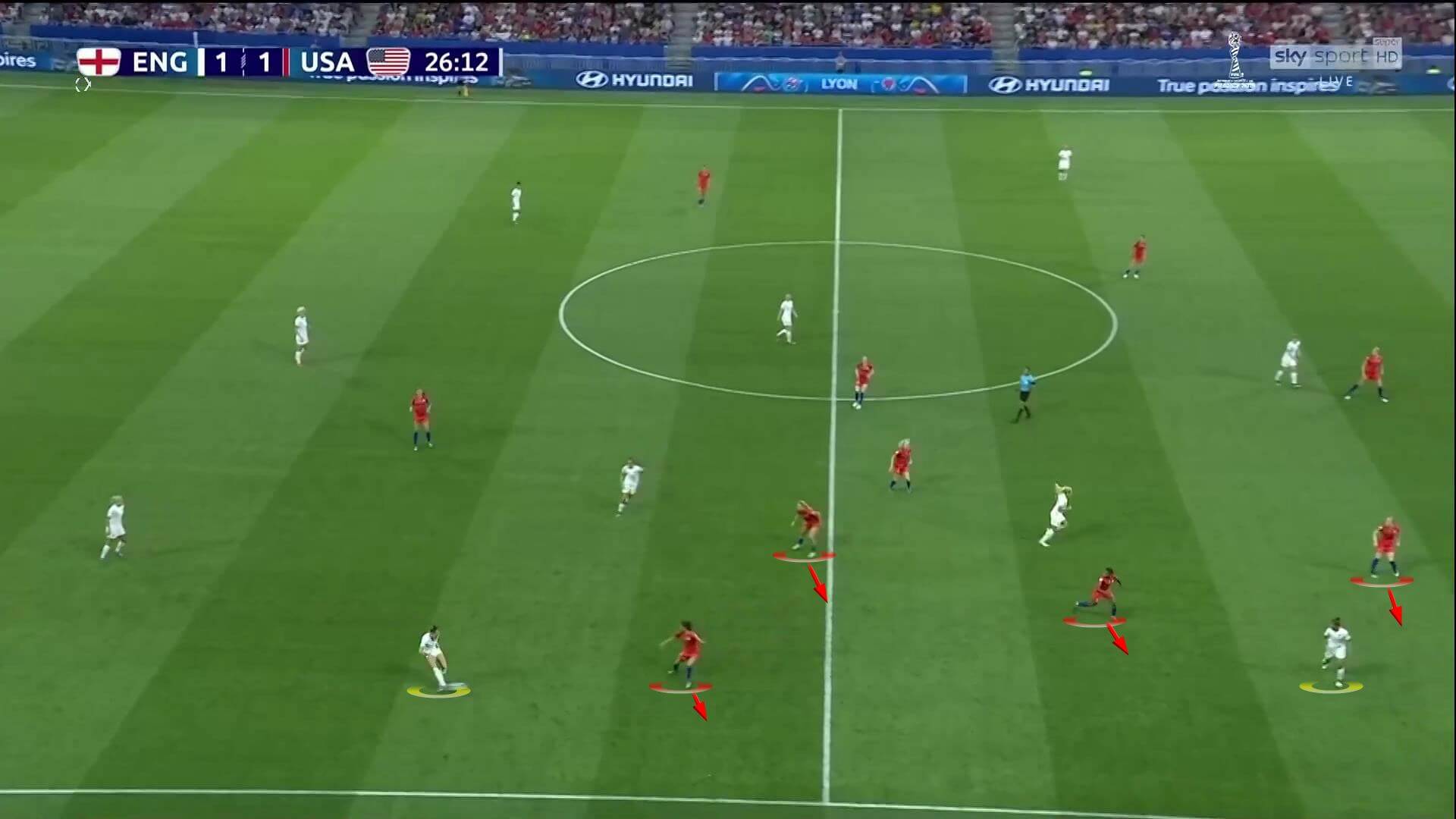
The world champions also took full advantage of Neville’s determined approach to playing out from the goalkeeper. When the moment was right and vulnerability was detected, Jill Ellis’ attacking players would apply pressure to the ball occupant while blocking off the short passing options.
Due to sloppy passing and sometimes poor positional layouts, England played numerous misplaced balls inside their first third. The next image illustrates this, as Telford gives it straight to Press on the edge of the penalty area. Her blushes were spared in the end with the attacker firing her shot wide, but it was an instance that represented some of the biggest flaws in the Lionesses’ approach.
Left centre-back Bright is positioned with her back to goal on a higher line than her defensive partner. Even she had received possession, she wouldn’t have had many options to progress the play. Meanwhile, Bronze is providing an out-ball in acres of space on the right and may have been an option for a lofted pass overpressure.
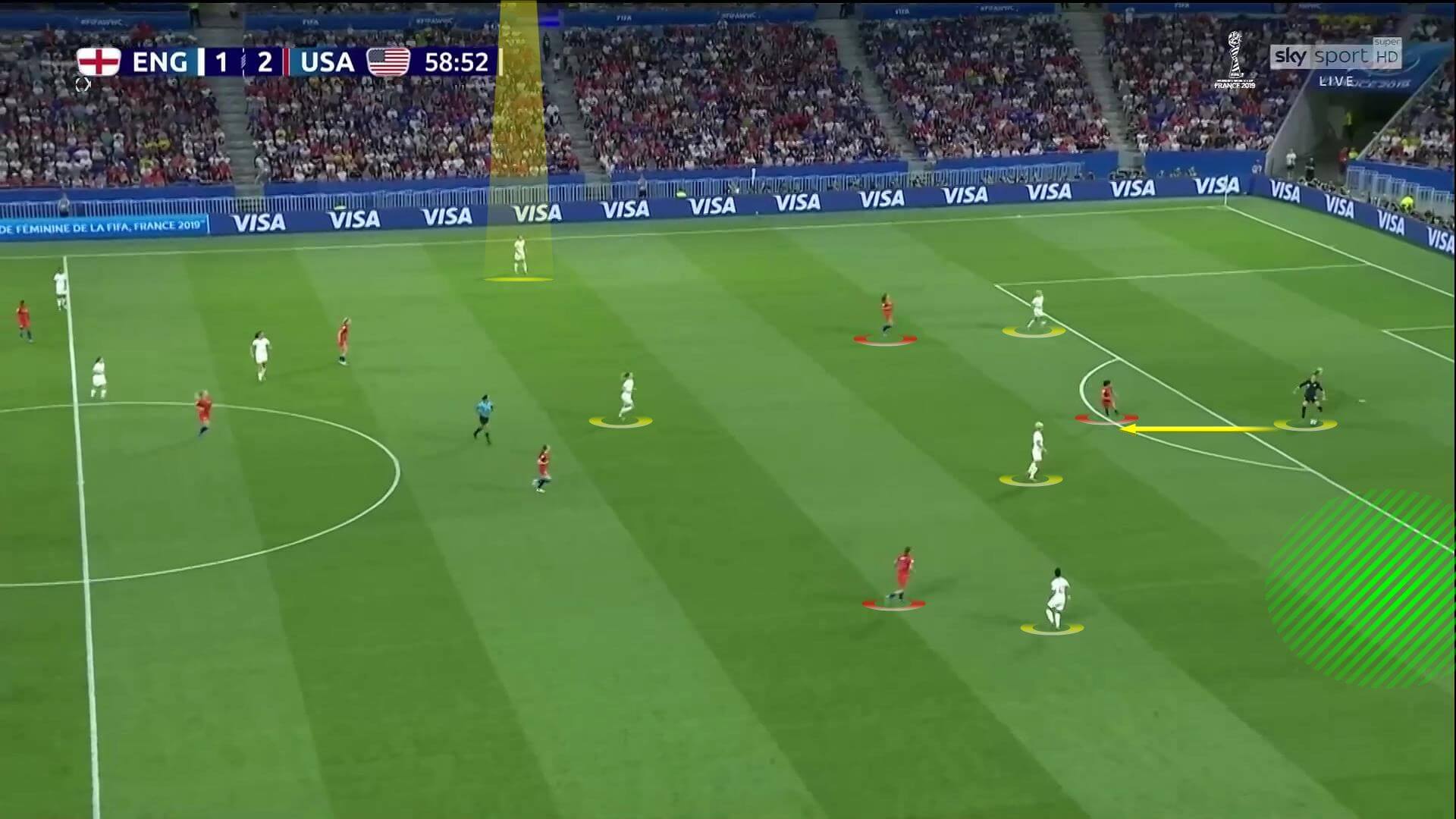
Admittedly, playing an Ederson style chip in the first phase of build-up is a lot to ask, and Telford’s teammates needed to provide better angles. Failing to apply certain receiving and positional play principles, as well as lacking the technical ability to play through an intense press, proved to be a significant issue for England against elite-level opposition. It will be interesting to see if Neville responds by revising his philosophy slightly.
Overcoming obstacles
Throughout the competition, England found ways to overcome the obstacles that were presented. However, it sometimes took until the next game for a solution to be put in place. The first image below is taken from the quarter-final victory over Norway, who applied a similar approach to previous opponents when it came to limiting the influence of Walsh.
Instead of placing herself centrally and looking to break free from the marking scheme imposed on her, she would sometimes move into the half-spaces. This opened up the central lanes for Houghton and Bright to play penetrative passes through to Scott and Kirby between the lines.
This is shown below, with Bright able to make a progression in central areas thanks to the decoy positioning of Walsh. Once Scott has received, she turns to feed Parris in a one v one scenario on the right.
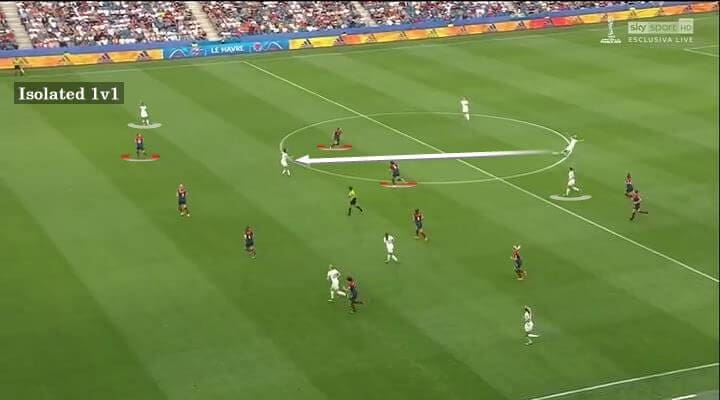
As we saw with Argentina, a number of the Lionesses opponents looked to defend deep and compact. One way in which this roadblock was overcome involved capitalising on any moments of slight disorganisation.
During the transitions between attack and defence, the opposition was suddenly vulnerable, with larger spaces to defend and more numbers committed upfront. England’s winner against the Argentine’s came under these conditions. After a rare attack from the South Americans, Scott completed a turnover in the defensive third. She quickly got her side on the front foot once more, feeding Kirby with space to drive forward.
The breakaway ultimately resulted in a simple tap in for Jodie Taylor, and a similar situation arose against Norway. The next image provides evidence of this, with Neville’s team mounting a counter at speed. A five against four is created in their favour as they enter the final third, where Bronze is brought down by a panicked Norweigen defender. The free-kick that followed saw the right-back score with a fine striker from just outside the box.
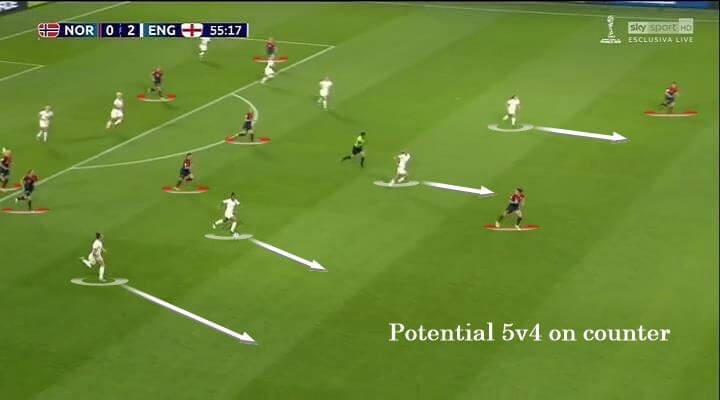
Dealing with the opponent’s attempts to congest the right-wing was also crucial to their progress. Houghton, the centre-back more comfortable on the ball, would often dribble towards opposing players, hoping to draw pressure in order to open up space behind them.
The next example shows her doing exactly that, with two Argentine midfielders engaged by the ball-occupant. The space on the flank is increased, allowing Parris to receive in a one v one.
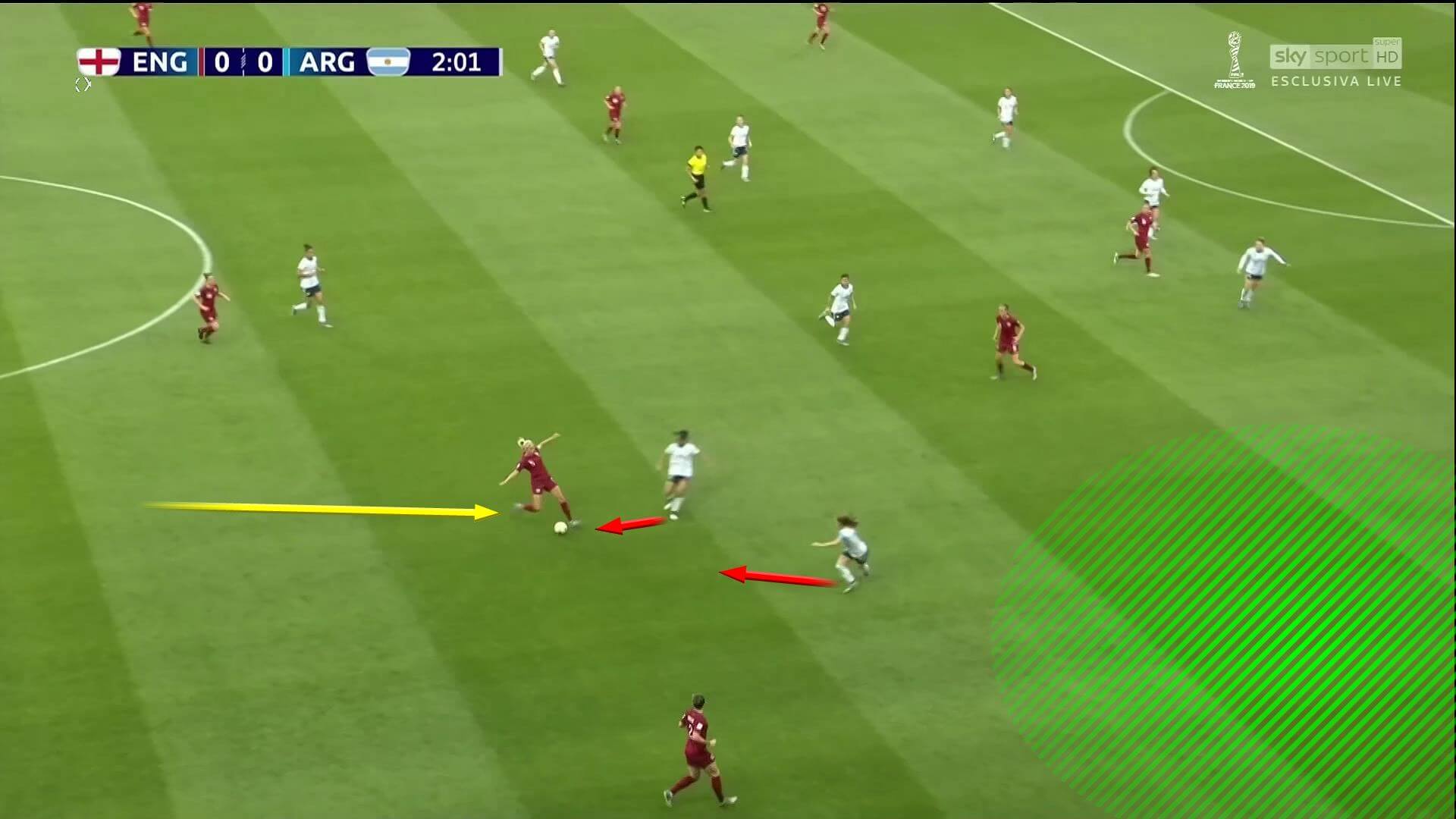
Given her close control and pace, Parris is able to excel in these instances, bypassing her direct opponent easily before delivering a cross to the box. Creating these duels formed an important part of England’s approach to possession, regularly building the play on the left before switching to the underloaded side and taking advantage of the space.
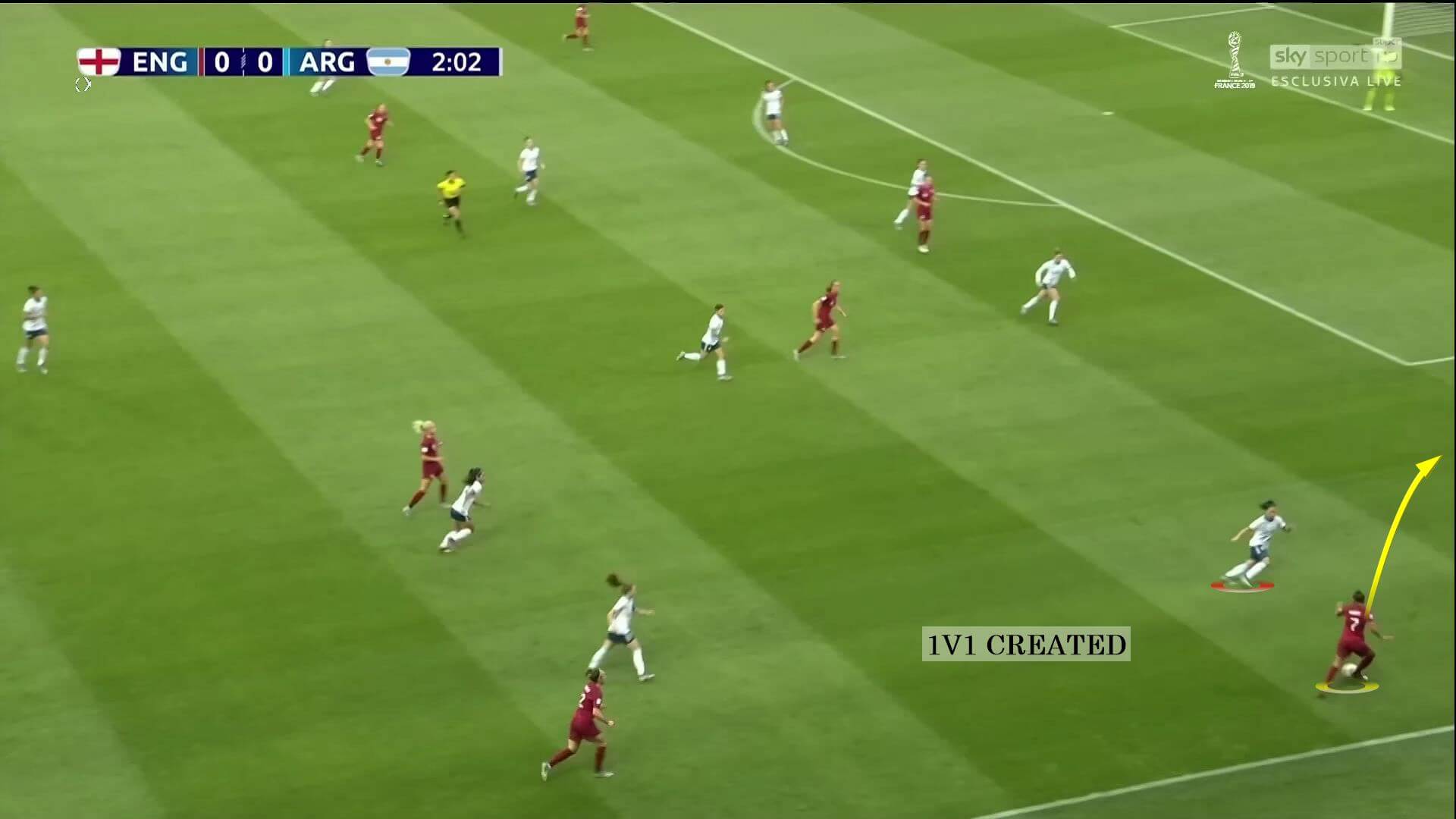
Switches of play from right to left were also influential, especially when the opponents were focusing on stifling Bronze and Parris. The USA, as we saw previously, were heavily orientated towards their left when defending deep. This generally prevented progress down that flank, but also freed up Beth Mead on the far side.
In the image below, we see Walsh play a diagonal cross-field ball, allowing Mead to receive in space. Striker White further supports the move by occupying the American’s right-back Kelley O’Hara, dragging her infield with a decoy movement.
Mead takes the ball down with a clean first touch, before finding White in the box for the equalising goal.
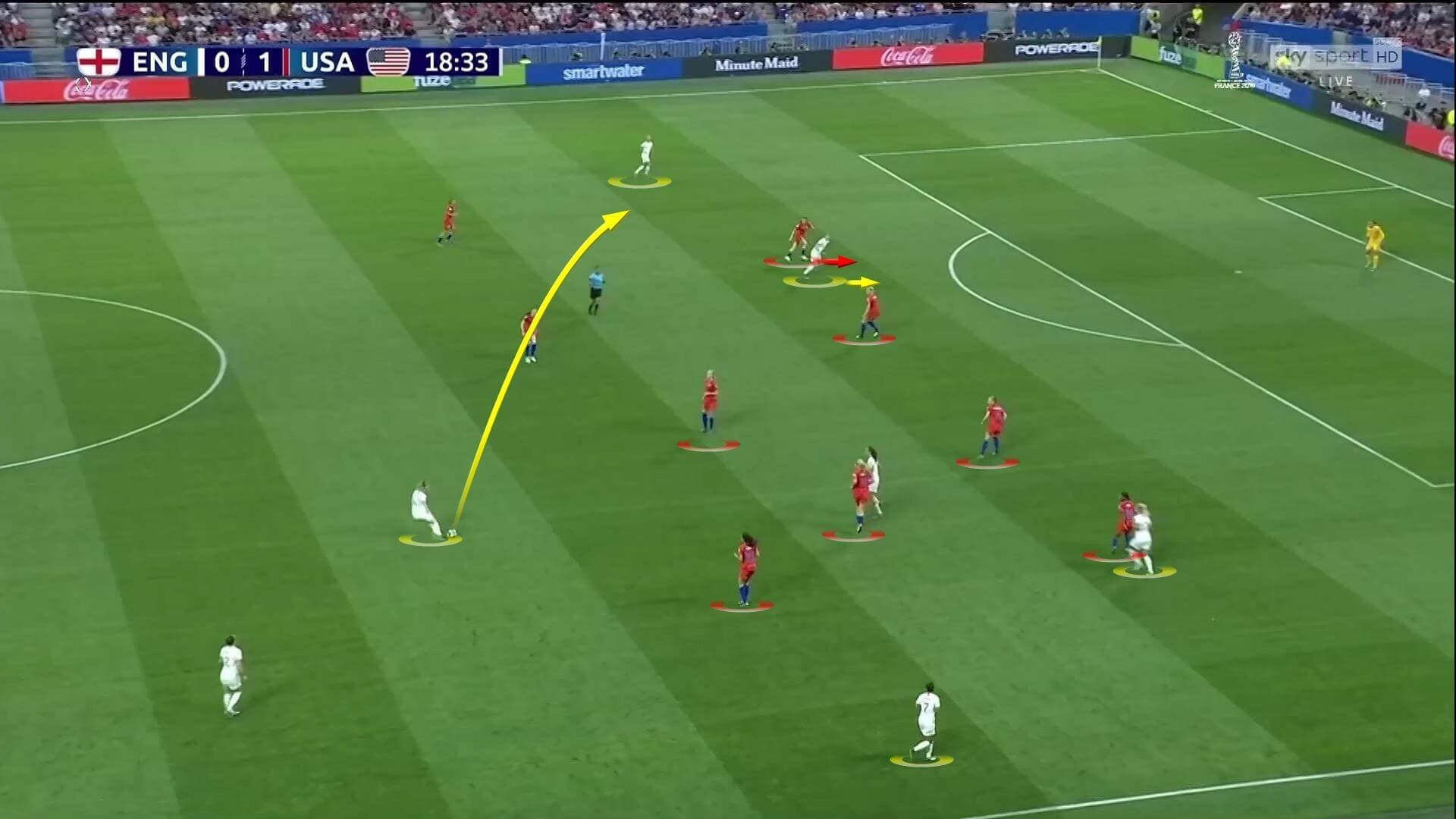
Overall, England succeeded in finding solutions to most of the obstacles put in front of them. They didn’t always overcome high-pressing and marking schemes during their first phase of build-up, and so there is plenty of room for improvement. Although their passing in these moments was often sloppy, their average possession statistics finished up at 59.77%, while they also completed 82.4% of their passes.
Defensive organisation and aerial weakness
Without the ball, Neville’s side also impressed, showing solid organisation during their established defensive phases. They also applied measured pressure at times to force opponents into making errors or playing long passes up-field.
The image below shows a typical structure with the US circulating possession along the first line. Parris and White occupy the holding midfielder with two lines of four behind them. As the opposition moves the ball towards the flanks, the ball-near winger would push up to engage the passing player. Meanwhile, the fullback behind her would also move out to close down the receiver. A three v two is created on the last line in order to try and have stability in the event of direct play.
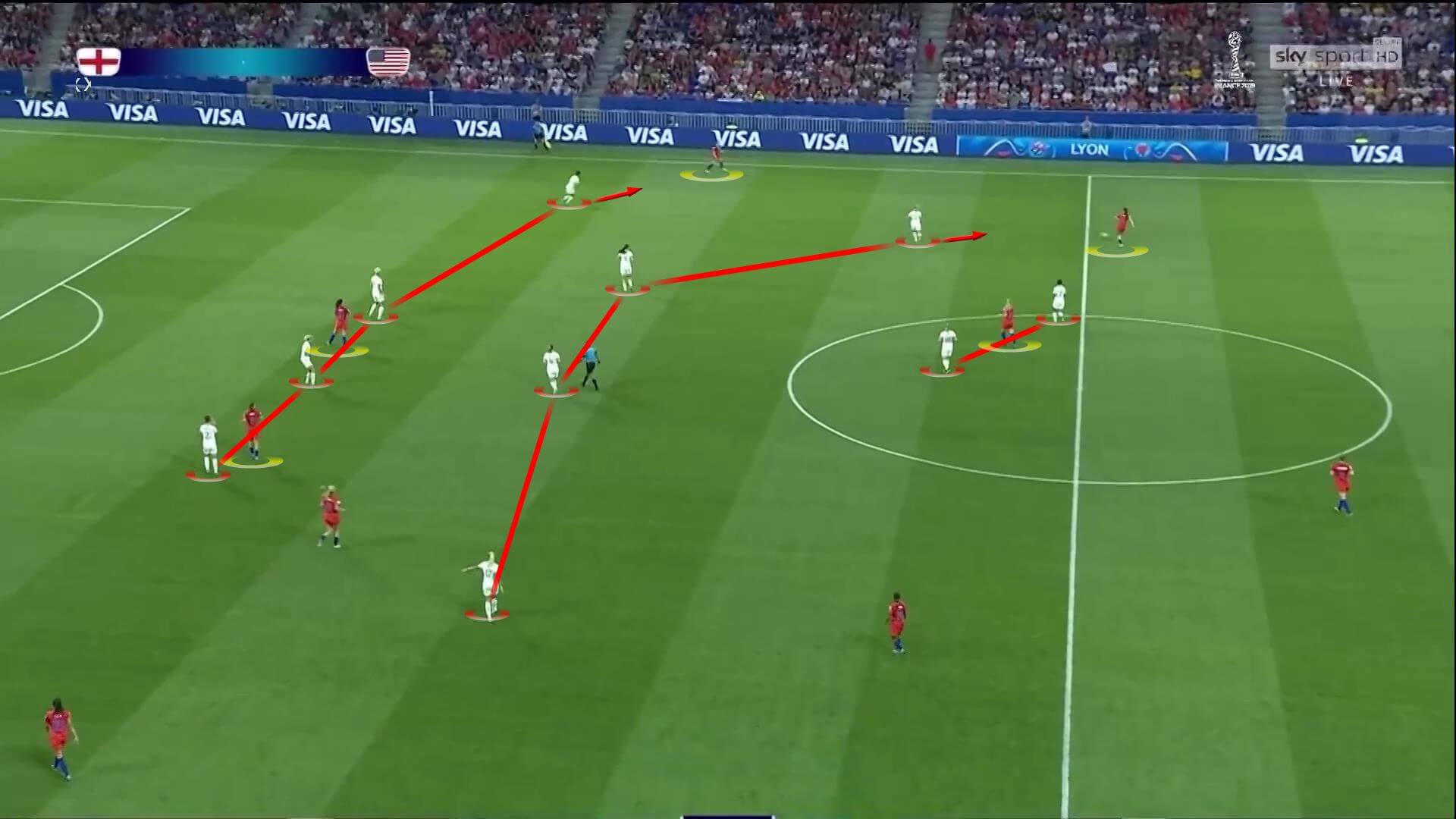
During the immediate moments following a loss of possession, they typically applied counterpressure to force a quick recovery and prevent a breakaway. Their approach in these instances varied from game to game, but the image below shows them using man-orientated counter-press.
Additionally, they looked to form traps or ‘false options’ for the ball-occupant. As shown, White, Scott, Kirby and Parris form a box while retaining access to the player closest to them. One of the two Norwegians within the trap receives possession, only to find the space around her close in and her passing options cut off.
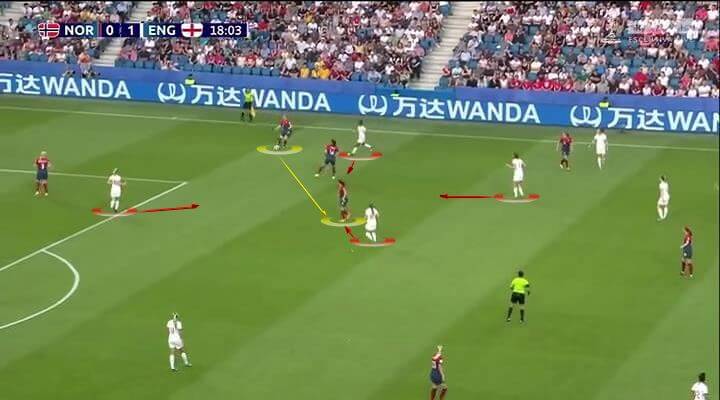
While their organisation from a defensive standpoint was impressive, there was one clear weakness throughout their time in France. It became evident early on that the backline found it difficult to cope with long balls.
As we saw earlier in this section, they often appeared well placed to deal with any lofted passes forward. However, these numerically superior structures weren’t always maintained, as shown by the next image.
Norway create a two v two on the last line, before playing directly over the top. Houghton goes to make a headed clearance but fails to connect with the ball properly. The chance isn’t taken by Isabell Herlovsen, with her strike sails over the bar.
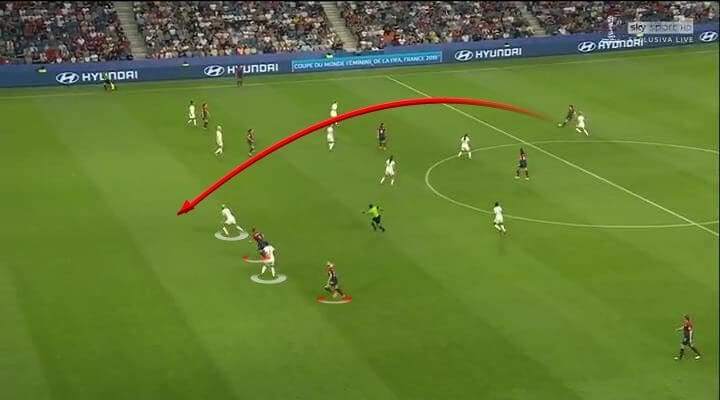
The moment highlighted above represents a reoccurring theme during the tournament, with almost all of their opponents looking to exploit it. Norway failed to take advantage, despite causing lots of problems, before England were eventually made to pay in the semi-finals.
Both USA goals came from lofted passes into the penalty area. The first, shown below, involved a simple cross to the back post, with Bronze failing to keep track of the runner behind her.
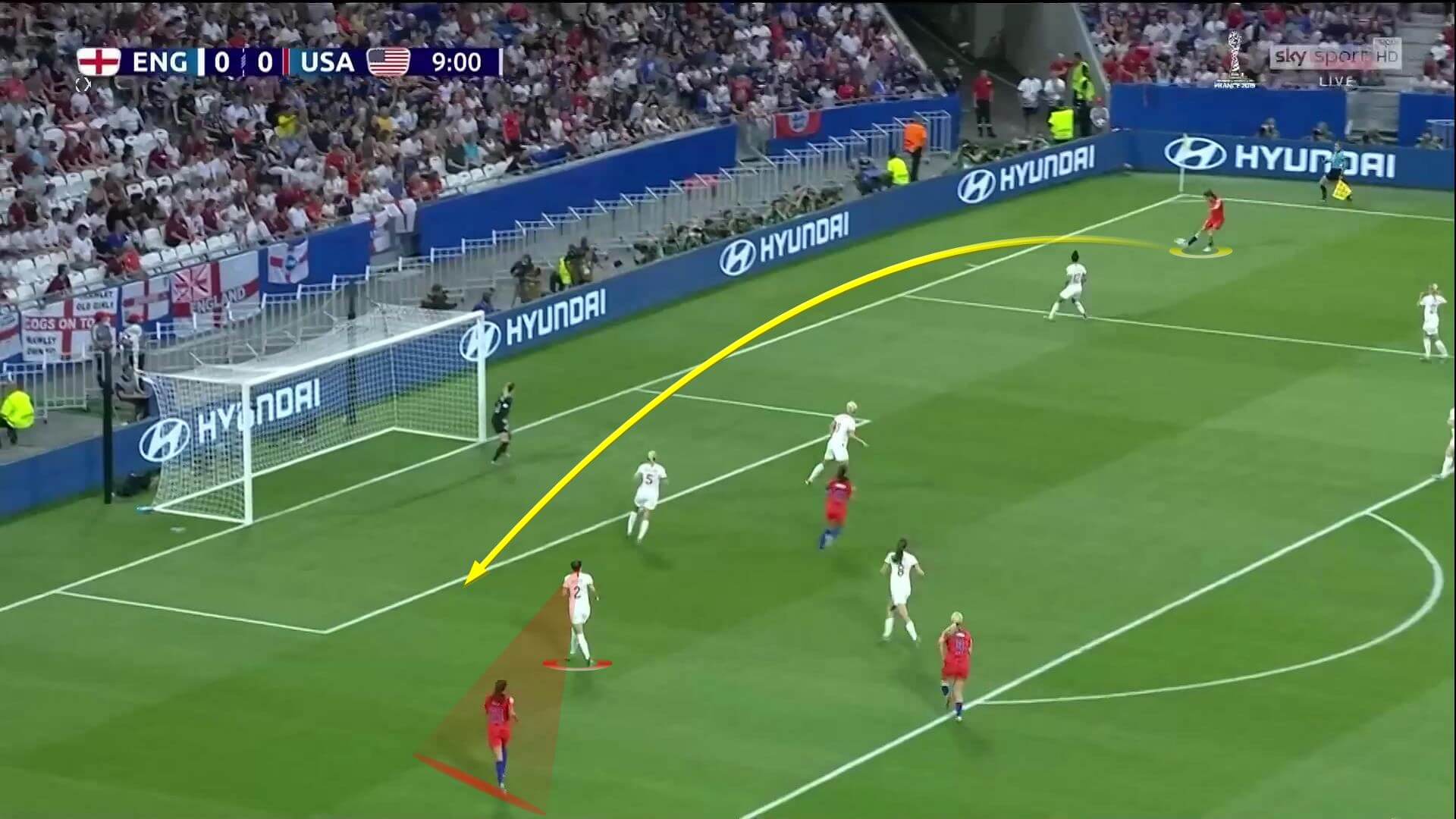
The second goal saw Alex Morgan arrive late into the box to head home, losing the centre-backs to exploit her height advantage over Demi Stokes. Numerous other opportunities were also created with aerial balls directed at Houghton and Bright, and it’s an issue that Neville must address.
Overall, the Lionesses performed well in the defensive phases, with any mistakes from the centre-backs generally arising in possession. They conceded just three goals, the same number as the US.
Creative set-pieces
Another interesting feature of their game in this World Cup involved the use of creative set-pieces. The men’s team scored nine goals from dead balls in Russia last summer, perhaps inspiring the women’s side to also make the most of these scenarios.
For their third strike against Cameroon, they successfully cleared a crossing lane towards the edge of the six-yard area. Their positional play drew the defenders away from the space, allowing Greenwood to arrive late and finish off the delivery from Duggan.
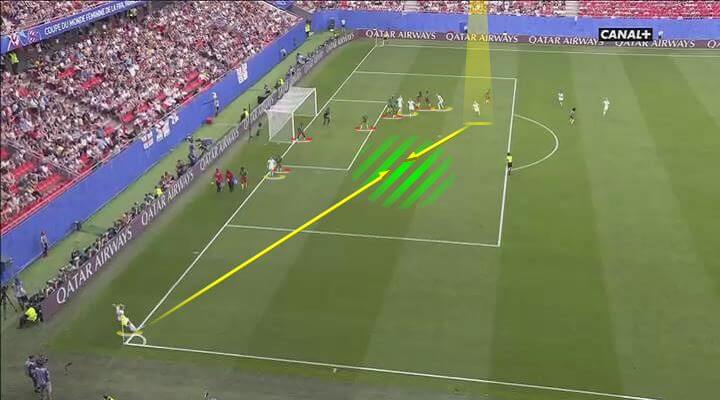
In their opening fixture against Scotland, they also managed to create a number of quality goalscoring chances from corners. The example below shows the ball as it’s delivered towards Scott, who has a clear height advantage over the surrounding defenders.
Multiple Scots are drawn to the immediate threat, before the 32-year-old heads it down for White to shoot first-time. The effort is well-saved but it was a moment that previewed what was to come in each of the games that followed.
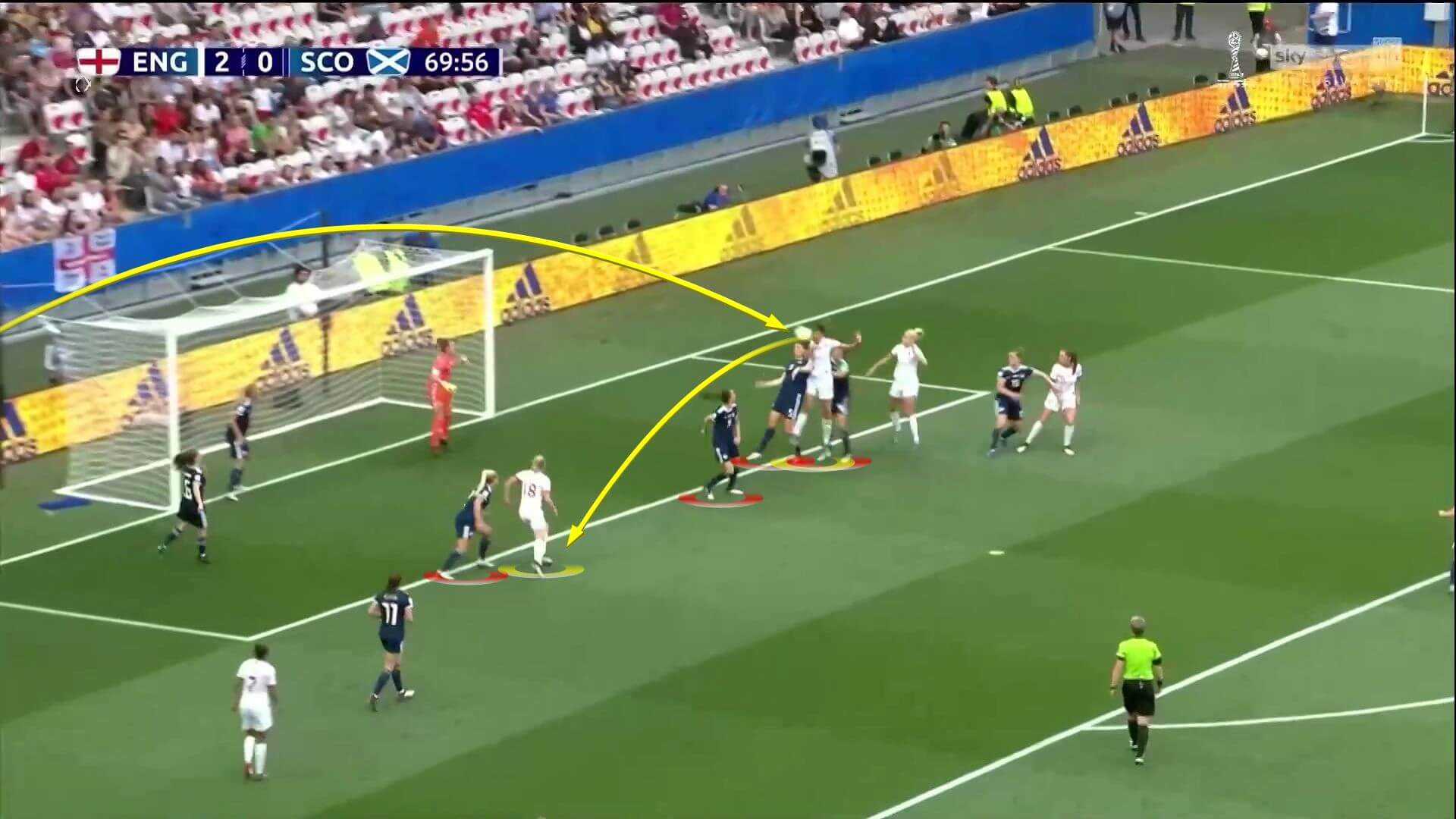
Against Norway, Bronze struck from range following a cut-back to the edge of the area. Once again, the England players engage each of the Norwegian defenders inside the box, leaving space on the outside for the Adidas silver ball winner to fire through the crowd and into the roof of the net.
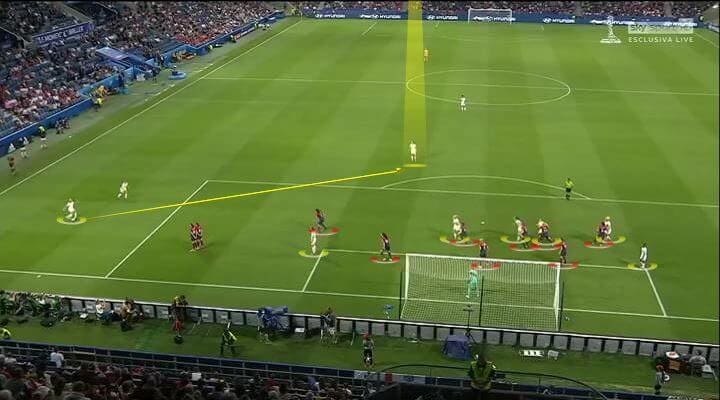
Despite missing three penalties, the Lionesses managed to rack up four set-piece goals in total. While the number doesn’t quite compare with their male colleagues’ record from last year, it’s an impressive tally nonetheless.
Right from the beginning of the tournament, it was clear that Neville and his side were keen to exploit every possible avenue when it came to chance creation, and they registered an excellent 13 goals from seven games.
Final Verdict
England’s ability to solve different problems in the offensive phases played a significant role in achieving a record of just one loss. However, as this analysis has shown, there is room to improve in their build-up play, as well as their capacity to cope with direct play.
Overall, they can walk away from this Wolrd Cup proud of their performances. While they might not have completed their ultimate objective of returning home as champions, there are many positives to take.
If you love tactical analysis, then you’ll love the digital magazines from totalfootballanalysis.com – a guaranteed 100+ pages of pure tactical analysis covering topics from the Premier League, Serie A, La Liga, Bundesliga and many, many more. Buy your copy of the June issue for just ₤4.99 here, or even better sign up for a ₤50 annual membership (12 monthly issues plus the annual review) right here.






Comments